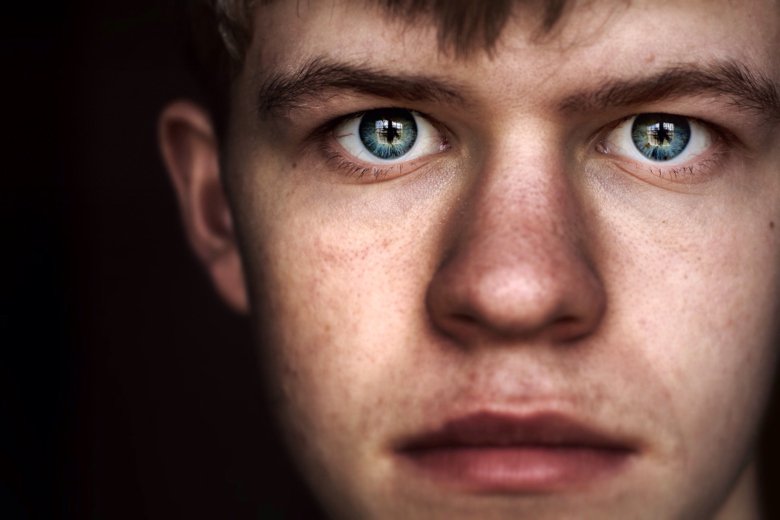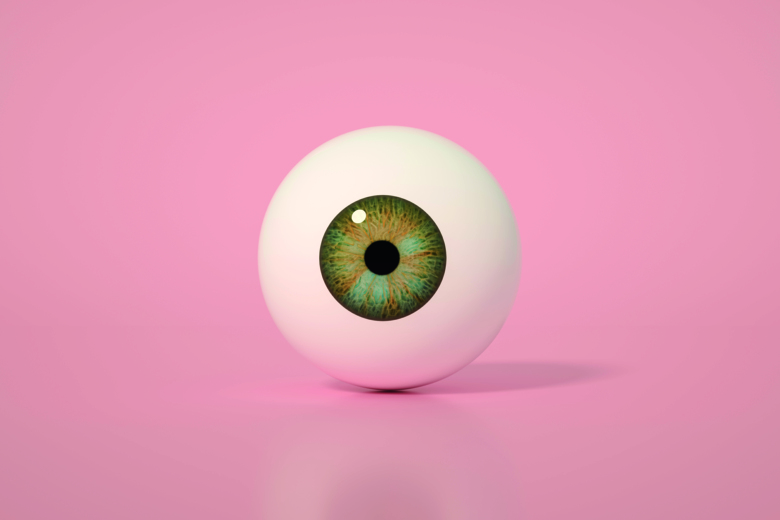The language of the eyes

You can drown in someone's eyes, or they might burn a hole right through you. The gaze is a shortcut to people's inner world, something researchers try to exploit to learn more about, for example, autism.
Text: Maja Lundbäck for Medicinsk Vetenskap no 4 2022
No matter how long we glare at an object, we cannot budge it from its position. No matter how intensely we stare at someone's back, that person will not notice anything. No, gazes are not magical, but they are nonetheless very important to the interaction between us humans. Being good at interpreting what is contained in a glance has probably been beneficial to us in terms of evolution.
Vision is a sense we have great power over. We have great power to choose whether to see or to look away. By moving our heads, changing the direction of our gaze with eye movements, and shifting the focus of our gaze, we can control which visual impressions are served up to the brain and which end up in the periphery.

“Our gaze acts as a sorting mechanism for our own attention,” explains Terje Falck-Ytter, researcher at the department of women's and children's health at Karolinska Institutet and professor at Uppsala University, who focuses on gaze behaviour in children.
The physiological ability to select and deselect sensory input is something we lack in the case of hearing, for example. We can neither aim our ears in another direction nor turn them off to avoid unpleasant sounds. If we look at someone's ears, it does not give us any clue about that person's world of thought. But we can discern this if we study what a person looks at – and for how long.
Most people keep track of where their fellow human beings look and what they pay attention to.
A gateway into the inner world of other people
“Gaze behaviour takes place out in the open, so the gaze is a gateway into the inner world of other people – and – is constantly revealing. On average, people shift their gaze three times a second. Where you look and for how long is closely linked to the situation and your intentions and feelings at the time,” explains Terje Falck-Ytter.
There is a precision in timing here that all of us, not just gaze behaviour researchers, are experts at perceiving. So, we will notice if someone's gaze is a little off. Eye contact that lasts too long quickly raises red flags within us. For example, a gaze that lasts too long can be perceived as a threat.
“You may feel unsure about what it means and wonder how to react to it,” says Terje Falck-Ytter.
How we move our gaze is automatic and is linked to other behaviours, such as what a person is talking about – and how. Parents are often quite good at telling whether their child is lying if the child does not make eye contact. Adults can train away that behaviour and become better at getting away with lying. But the cognitive process of lying takes its toll anyway, explains Terje Falck-Ytter.
“People can perceive that there is an internal process going on here, that it is not flowing.
It is mainly gaze behaviour – how quickly someone looks away, for example – that is most important for communication between people. But what about pupil size? What does that mean?
“First and foremost, the pupil regulates how much light enters the eye. Beyond that, pupil size is related to a person's level of alertness or arousal. However, so far we know little about how this information is actually used in everyday communication and social interaction,” he says.
Larger pupils may nonetheless be a signal that the person you are talking to is getting fired up.
“Experimental studies looking at reaction to pupil size seem to indicate that we match pupil size with other people. One hypothesis is that it might be a way of syncing arousal or alertness,” he says.
Terje Falck-Ytter has found a link between eye pupil size in five-month-old children and increased genetic vulnerability to schizophrenia. Large pupils were correlated with higher genetic risk.
“It was an unexpected finding and we do not really know what it means. But previous research has found many differences in how patients with schizophrenia pay attention to the environment. In light of this, our finding from infants is interesting,” he says.
Our fastest way to communicate is through eye contact. And there is no doubt that emotions are conveyed effectively when gazes meet.

“An angry, encouraging or loving glance can quickly convey what we would need several words to explain,” says Arvid Guterstam, a researcher at the department of clinical neuroscience at Karolinska Institutet who studies the interaction between attention and social cognition.
A good empathy for the inner mental life of others, or “the theory of mind” as it is known in scientific circles, is beneficial.
“We like to know what others around us are looking at, because then we can get clues about what is going on in their brains. This gives us important information, which may even be important for our survival,” says Arvid Guterstam.
If we can sense the mental content of others, we can also predict what they will do next, he explains. If we can figure that out, we can adapt our own behaviour in the best possible way. A classic way to test this ability in children is to have them watch someone put a ball in a box. When the person looks away, another person comes and takes the ball. Then the first person looks back at the box. The child is asked – where does the first person think the ball is? If the child answers that the first person thinks the ball is in the box, the child has got it. Studies have shown that people with autism have an impaired ability to imagine what others are thinking.
“There are studies that show that, with practice, they can improve this ability, although it may not come as naturally and intuitively as with others. Theory of mind capacity is very important for our social skills,” he says.
Can be felt as physical beams
Being the centre of other people's attention can be hard for us. When many people are staring at us at the same time, it is common to get sweaty and nervous. For example, standing on a stage makes the heart beat faster. It can feel like eyes are burning a hole into you, as if the gazes were physical. But it is our brain that is tricking us.
“On a subconscious level, the brain processes glances like physical movement, like a beam streaming from someone's eyes,” says Arvid Guterstam.
It is universal that children experience vision as working from the inside out, so to speak, rather than from the outside in. Historically, this has also been true of adults in many cultures.
“The idea of ‘eye beams’, also known as the ‘extramission theory’, is an old folk psychology notion that has probably existed for as long as there have been human beings,” says Arvid Guterstam.
Whether or not we, like small children, believe in the idea of “eye beams”, our brains will process the direction of others' gaze as a beam of movement through the air, he says. Thus, this applies even if you have intellectually understood that eye beams are a false theory of how vision works, he explains.
Arvid Guterstam saw this a few years ago in both brain imaging studies and experimental studies. In one study, he found that when people are asked to judge how much an object tilts and at what angle it “tips over”, their response is unconsciously influenced by a face staring intently at the object, as if the gaze were exerting a slight physical force.
“But the effect disappeared if the face looked away or was blindfolded, suggesting that the brain interprets the visual attention of others like an invisible substance flowing through the air and even physically interacting with objects,” he says.
But it is not a huge impact.
“The force is roughly equivalent to a light gust of wind,” he says.
Because the eye beam mechanism is activated specifically when we perceive the directed attention of others, Arvid Guterstam says it could be important for the ability to do theory of mind, something he plans to investigate in future studies.
The gaze gives clues about autism
If we want to persuade someone to act in a certain way, it is often effective to meet and follow the person's gaze. We do this all the time when we engage in “joint attention”. This is something that people with autism can find difficult.
There is a perception that children with autism avoid eye contact, but the research is not so clear. So says Terje Falck-Ytter, who studies young children with autism, as well as infants who are later diagnosed.
“When we measure gaze in our studies, we do not find that babies who later develop autism look others in the eyes less than other children in general,” he says.
Among infants in general, there is a wide variation. Some look at eyes more, others at mouths – and most start looking more at mouths when they start learning language. But not all. Some look at the mouth much more even at an earlier age. A study by Terje Falck-Ytter on five-month-old twins shows that this behaviour is hereditary, but probably not linked to autism.

His studies also show that infants who were later diagnosed with autism were equally good at divided attention, responding to an adult's initiative and following their gaze. But there was a sub-element of an experiment that nonetheless reveals differences in gaze behaviour in children with autism – differences in whether they used their gaze to initiate shared attention with the adult themselves. At 10 months of age, children who later developed autism were not as good at soliciting adult attention to “tell” something with their eyes.
“This seems to be an early sign of autism. There was a clear group difference, but not so clear a difference that it can be used as a test at the individual level,” he says.
Autism is not the only diagnosis that stands out. In other neuropsychiatric as well as psychiatric diagnoses, gaze behaviour is also slightly different.
“Gaze is related to thinking and what you are interested in. If you think differently from others,
it will affect how you use your gaze. In individuals with ADHD, we have seen that they do not maintain a gaze on a picture as long, even though it is necessary to solve a task,” says Terje Falck-Ytter.
How much does our early gaze behaviour shape us as individuals? How does a child's gaze behaviour influence the parents' behaviour? These are fascinating and important questions, according to Terje Falck-Ytter.
“Our gaze largely determines what information the brain receives. And genes contribute to your exposure to certain information, certain environments. I find it so interesting that gaze behaviour is hereditary in all of us,” he says.

Did you know that...
...gaze affects memory?
Both gaze direction and eye movements are involved If we direct our gaze and move our eyes in the same direction and in the same order as when our memory was encoded, we will also remember the event better and in more detail.
... pupil size affects our sense of trust.
If we look at a person whose pupils dilate on eye contact, our own pupil size is likely to increase – and at the same time we will feel more trust in the person. The opposite reaction occurs when we look at a person whose pupils decrease in size when our eyes meet.
Source: Proceedings Biological Sciences, Psychological Science
